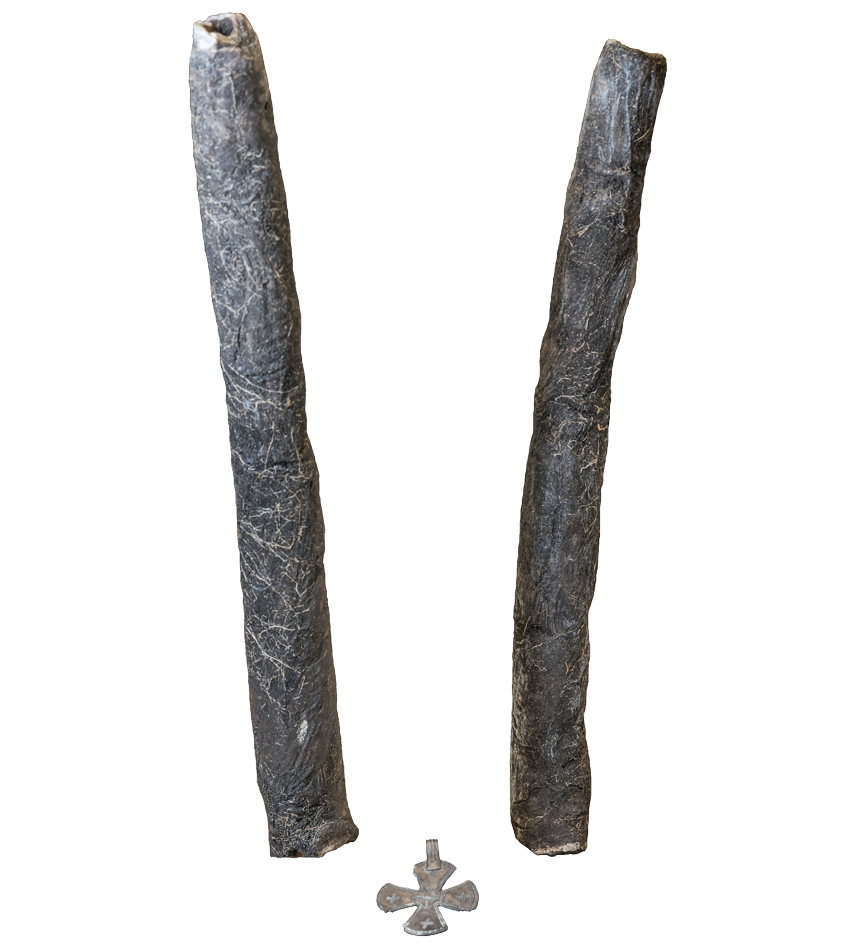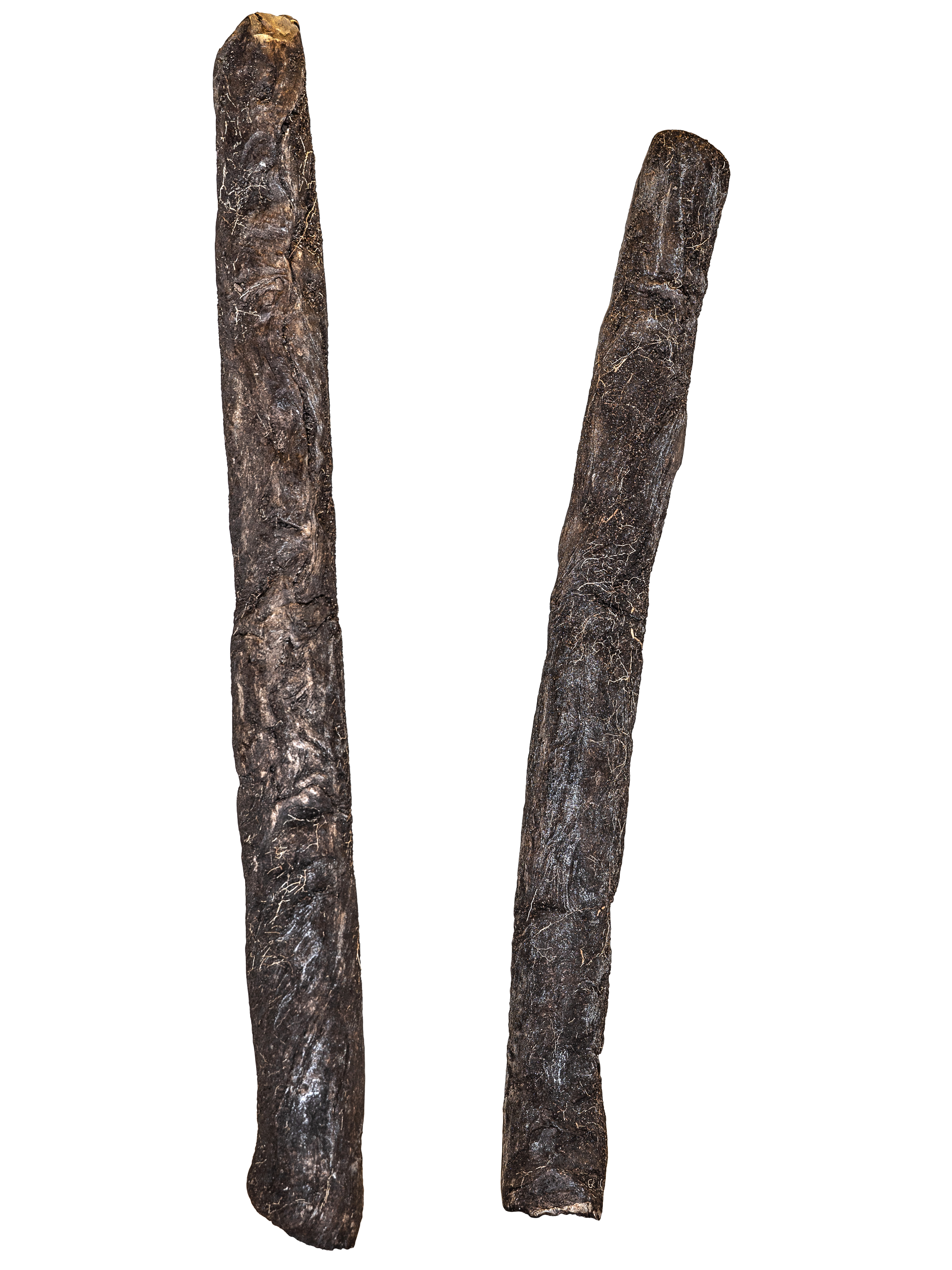Wax candles and a next-to-skin cross – a complex of items from a woman’s burial



Candles have cylindrical shape made of convolved wax plate edges of which are tightly pressed butt-to-butt. Candles from Gnezdovo are 30 cm long and their diameter is up to 3 cm. Prints inside channels mean that these candles had wicks made of several intertwisted threads.
The cross from Gnezdovo was cut from a thin silver sheet. It is decorated with puncheon ornament along the edge. It has a fixed hold (for a lifting bar). Ornaments were applied with a cog castor or a puncheon that allowed applying ornament of tiny circles. The puncheon itself could be an imitation of granulating (a more complicated technique that included soldering small balls on the surface). In the center of the crossing and on brunches – images of crosses.
A complex of candles and a next-to-skin cross from the burial mound C-301 is unique, it belongs to the rare category of Christian burials of the middle-the second half of the X century on the territory of the Ancient Rus’ and witnesses the start of Christianity spreading before the official Christianization of Rus' in 988. The fact that there were Christians in the ancient Russian Druzhina was fixed in the text of the treaty between Rus and Byzantium in 944 that says: “Russian Christians were administered the oath in the church of Saint Ilia…as there were a lot of Christian-Varangians and Khazars”. Christianity penetrated to Rus’ through the Scandinavian druzhina members, that familiarized with the new religion and partly accepted it during their military expeditions to the West and to Byzantium.
It is noticeable that among the burials with Christian symbols prevail woman’s Scandinavian burials (if we consider all known cases of finding such objects), that were traditionally in historiography referred to the culture of druzhina’s burial mounds” – the burials of the society elite.
Such burials of the end of the X or the beginning of the XI centuries are known in Timerev’s, Gnezdovo’s, Kiev’s, Vladimir’s mounds.
It is worth to notice the following specialty: in composition of the grave goods of Ancient Russian burials with candles and crosses vessels with mournful food were found, armament supplies and a personal attire of the dead, sometimes paired burials were found. To sum up, the ritual had both new cultural symbols (Christian) and old pagan traditions.
Similar situation we can observe in burial mounds of Scandinavia, in particular in Birka (Sweden). Western archeologists mark the duplicitous nature of woman’s burials with crosses (keeping pagan traditions), that reflects incomplete Christianization mentioned in sagas.
The exposition presents early-Christian artifacts from four burials in which candles were found, cross-like pendants, and a vessel with a cross-shaped molding. Among them are the burial mound C-301 from Gnezdovo (candles and the cross), the burial mound 100 from Timirevo (wax candle), burial mound 457 from Timirevo (a casted cross of Scandinavian type), the burial mound 430 from Timirevo.
The burial mound C-301. Under the mound a woman’s chamber burial (in a crib/сhamber) was found. In a hole 3x3 meters in size and 0,8 meter in depth remains of chopped crib 2,1x2,1 meters in size were chipped away. The crib was covered with a shelter of planks at the top. Among implements on the floor of the crib were found: a necklace of glass beads, a fragment of equally-shouldered bronze fibula, fragments of an oval fibula, a birchbark basket, fragments of linen clothing, imported eastern and Byzantium silk fabrics that remained in the basket of birchbark, a silver cross-like pendant with a puncheon ornament and a soldered hold, a bucket, a circle vessel with a lineal ornament. Also in the burial were found fragments of 9 more candles. Most of these candles had melted edges.
Gnyozdovo (Gnyozdovo archeological site) is one of the biggest trade and craft early-city centers of Ancient Rus and a predecessor of historic Smolensk – the capital of the Ancient Rus of the XII-XIII centuries.
Gnyozdovo is located in 13 km from modern Smolensk. It includes several archeological sites on both banks of the Dnieper river: 1. The central hillfort and a settlement near the place where the river Svinec fall into the Dnieper river; 2. Olshansky hillfort and settlement near the place where the river Olsha fall into the Dnieper river; 3. Eight burial mounds’ groups on both banks of the Dnieper river: Central, Forestal, Glushenkovskaya, Left-Bank, Dnieper, Olshanskaya, Zaolshanskaya, Nivlenskaya.
The first description of these burial mounds’ groups and the hillfort was made in the beginning of the XX century by S.I. Sizov. In the 20-ies of the XX century in burial mounds’ groups about 4500 mounds were counted.
Examination of Gnezdovo, its burial mounds at the first place, started in 1874 after one of the richest ancient Russian hoards was found.
After the longstanding research of the Gnezdovo complex discussions around its historical interpretation and its chronology, type and political status in the times it existed are continuing.
Some researchers assumed, that Gnezdovo was a point of control over snaking trails (a snaking trail is an area between two waterways through which the vessel was dragged to continue the way) from the Dnieper river to the Dvina river, “an open trade and craft settlement” with an inconstant structure of population, which rise and fall was connected with serving the waterways: moving merchants and military groups on the Dnieper river and also functioning of the market.
According to the other point of view, Gnezdovo was one of the points of national settlements headed by Kiev, trading post, connected to the administrative-fiscal activity of druzina of the grand prince – poliudie. Vast necropolis of these archeological site is interpretted as a cemetery of a druzhina. Population of Gnezdovo besides the druzina members consisted of craftsmen and farmers who served in grand prince’s land. Not denying the importance of craft and trade in population’s life, supporters of this idea suppose, that its smithcraft and gold-work were oriented to the needs of druzhina in the first place, including crafting expensive items that were meant to decorate the everyday life of druzhina elite.
The third conception states that Gnezdovo was an early-city center of the period of the infancy of the Ancient Russian state with developed trade and craft functions, stable demographic situation and obvious differentiation of its population. According to materials of the burial mounds and settlements, Gnezdovo’s society included groups of people connected with military service, distant and close trade, crafts and agricultural activities. Aristocratic elite existed in Gnezdovo as good weaponed warriors and mostly of Scandinavian origin.
The latest burials of Gnezdovo are dated the last quarter of the X – turn of the XI century.
Along with the adoption of Christianity in Rus and in Scandinavia the transformation of the pagan culture and funeral rituals happened. In the end of the X – the first half of the XI centuries specific traits of Scandinavian funeral ritual became lost, the number of things of northern origin decreased rapidly.
The decline of Gnezdovo is mainly connected to the graduate end of Arabian silver coins import in the end of the X century. Simultaneous entrenchment of power of princes of Kiev in the end of the X – the beginning of the XI centuries decreased the Scandinavian flow to Rus and changed their position: in times of Vladimir and Yaroslav they served as hired warriors in druzhina of the grand prince. It is not excepted that one of the factors of Gnezdovo decline was the climate change in the region, starting from the XI century, it becomes more warm and humid, regular floods had been resumed (the rise of the water level because of fast melting of snow and rains) in the flood plain of the Dnieper river.


